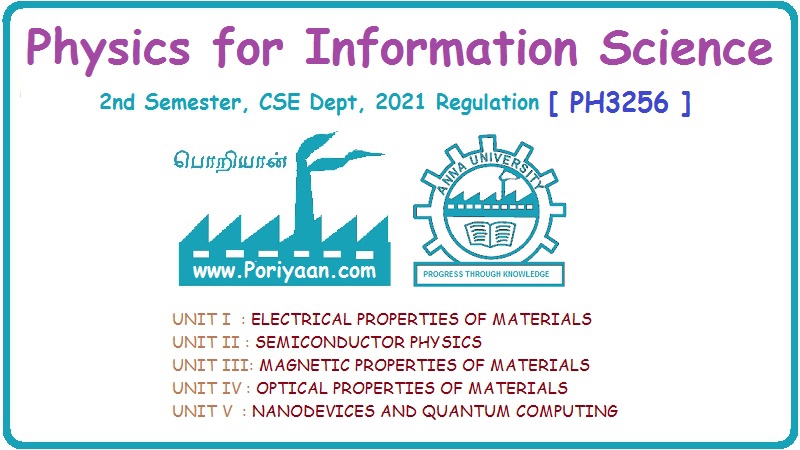Physics for Information Science: Unit IV: Optical Properties of Materials
Data Storage in CD/DVD's
Construction, Working Principle, Design, Storage capacity, Operation, Applications
CD/DVD comes under the category of a permanent storage device, used in computers.
DATA STORAGE IN CD/DVD'S
Introduction
CD/DVD comes under the category of a permanent storage device, used in computers.
We all are familiar about a Floppy disk, which is a magnetic storage device, in which the datas are stored and retrieved using magnetic pulses. Since it can store very less number of datas, nowadays CD's are used.
CD/DVD is an optical storage device which is capable of storing large number of datas than a Floppy disk. For example one CD can store 1000's of pages from a book (or) many softwares also.
Principle
CD/DVD uses the principle of writing the datas using a high power laser beam and reading the datas using a low power laser beam, by forming pits (0's) and lands (1's) over the CD.
Design of a CD/DVD
CD/DVD is a plastic (or) photo-polymer disk madeup of poly-carbonate, grown over the substrate. It has a diameter of 120 mm and thickness of 1.2 mm, with a circular hole of diameter 15 mm as shown in Fig. 4.26. In this disk the datas can be stored in tracks and sectors, from 46 mm to 116 mm of diameter. The magnified portion of data storage is indicated in Fig. 4.27.
Since we are going to use laser light for writing and reading the data, the reflectivity at the top surface should be increased. Therefore a layer of silver (or) aluminium is deposited as vapour over the poly-carbonate surface as shown in Fig. 4.28. A protective layer protects the CD from dust and moisture.
Note: In Re-write CD's, a layer of "metallic alloy" is present inbetween the polycarbonate and reflective layer. Here the phase changes from amorphous (0's) to crystalline (1's), during writing. The reading can be easily done, as the crystalline material reflects more light (1's) than amorphous (0's). Further, the data can be re-writed by making the top layer as non-reflective instead of reflective layer in CDs.
Storage capacity
The storage capacity in CD's depends on the number of sectors and the number of bytes (8 Bits = 1 Byte) per sector. It is given by the formula, i.e.,
Storage capacity = Number of sectors × Number of bytes per sector
Recording/Writing Process
Fig. 4.28 shows the system used for recording/writing the datas over the CD and also for retrieving/reading the datas from it.
Initially all over the CD we will have lands (1's) of highly reflectivity. Now to change it as 0's and 1's a high power laser is directed towards the surface of the CD through the condensing lens C1, beam splitter (Bs) and condensing lens C2 as shown in Fig. 4.28.
This high power laser beam burns the surface of the CD and creates a small hole called pit, corresponding to 0's of 0.8 μm diameter.
By similar method wherever we want 0's, laser should be focussed and pits are created and the remaining area will be as such as lands i.e. 1's.
Therefore the pit (0's) represents the burnt area and the land (1's) represents the unburnt area in CD. Thus the datas are digitally recorded/written over the CD.
Retrieving/Reading Process
During the reading process low power laser beam is directed towards the CD through the condensing lens C1, beam splitter (Bs) and the condensing lens C2. Based on the reflectivity of the surface, the intensity of the laser beam is modulated i.e., The land (1's) (unburnt area) which has high reflectivity, reflects more light than the pits (0's) (burnt area), which has low reflectivity.
The modulated laser beam which has the datas in the form of 0's and 1's from the CD is diverted to fall on the condensing lens (C3) with the help of the beam splitter (Bs) as shown in Fig. 4.28.
The condensing lens focusses the light onto the photo-detector. The photo detector detects the laser light falling over it and is stored for further processing. Thus the datas (0's and 1's) are retrieved (or) read.
Applications
CD/DVD has a wide range of applications, viz.,
(i) It is used to store large number of datas in the form of files.
(ii) They are used in marriages (or) any functions.
(iii) It can be used to load many softwares.
(iv) CD/DVD is also used to store the datas in the form of both audio and video.
Physics for Information Science: Unit IV: Optical Properties of Materials : Tag: : Construction, Working Principle, Design, Storage capacity, Operation, Applications - Data Storage in CD/DVD's
Related Topics
Related Subjects
Physics for Information Science
PH3256 2nd Semester CSE Dept | 2021 Regulation | 2nd Semester CSE Dept 2021 Regulation
